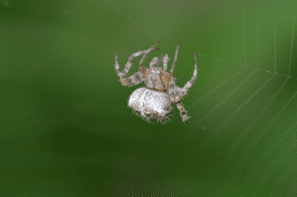SPOTTED!
Wildlife in (and around) Hailsham
by Tim Fox
At around about this time of year, the lavender and other stemmy plants develop webs as our Common Garden spiders set up home to feast and fatten up ready to lay eggs (that will bring us next year’s spiders), before dying off in the cold weather. Also known as Cross (or Crowned) Orb Weaver or Diadem Spider, araneus diadematus, the species can vary in colour from a light brown to a dark grey, but the most prominent feature (apart from having eight legs!) is the white cross upon its back, which is the origin of the name Cross Orb Weaver. Diadematus in the name relates to another prominent feature which is the prominent bulge on the head of the spider, which someone thought looked like a crown and, with a diadem being a type of crown, the name stuck.
They spin a delicate but deliberate structure starting at the outside with the anchor points, building a frame, and then working in ever-decreasing circles towards the centre of the web where she will sit, head down, awaiting breakfast, lunch and dinner to be ensnared on the vertical trap. We have both light and dark variations in the front garden this year, proving quite a distraction as they slowly but methodically repair the web when a bumble bee has flown through, or quickly wrap their latest meal in silk ready for the juices to be sucked dry. I mention that “she” sits in the centre of the web since, whilst male spiders can spin webs, they are mostly nomadic and out looking for “love”, and so a web, which is a heavy investment in time and energy, is wasted on them.
I was fortunate to spot a male at the edge of one of the ladies’ webs this year – a noticeably much smaller abdomen, and with stripy and much longer legs (all the better for running after prey). He was tolerated for the day, but I noticed in the evening that he had disappeared, and I’m not sure if he chose to leave, or he found “love” and, after the act, became dinner. It does happen. Pic: Credit Tim Fox
[First printed October 2021)













